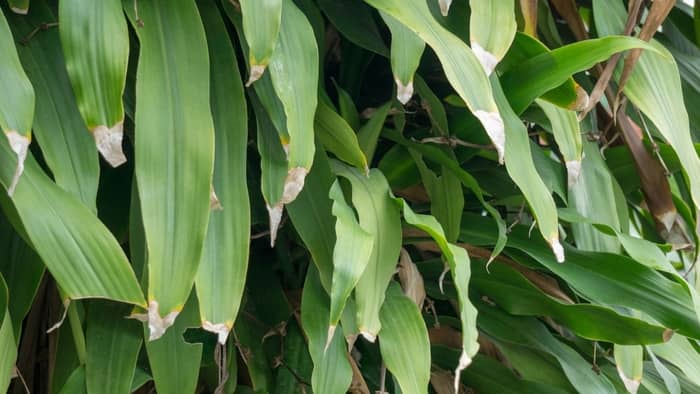Last Updated on January 23, 2022 by Fabiola L.
Ammonia is a common nitrogenous compound from decaying organic matter that will kill plants if not in it’s stable forms. There are cases in which ammonia will kill plants if too much is applied. Ammonia-based fertilizers, specifically urea, is still widely used in agricultural applications as an affordable nitrogen fertilizer. It is found in a wide variety of industries, as refrigerant, smelling salts, or cleaning products. Ammonia by itself is a colorless gas with a distinct smell. It can be produced through natural processes like decaying matter or natural byproducts or industrially manufactured.
Ammonia Will Kill Plants, But Ammonium and Urea Are Major Sources Of Nitrogen In Agriculture
Plants depend on nitrogen for chlorophyll, proteins, energy, and amino acids. Nitrogen boosts plant vegetative growth and has the highest concentration out of all other than carbon, hydrogen, and oxygen. Majority of the fertilizers in the world come from urea which breaks down partially into ammonia and ammonium in the presence of water. This makes ammonia and ammonium an important part of agriculture.
Sources Of Ammonia-based Nitrogen In Your Aquaponics System Include Your Fish Feces.
In aquaponics, fish feces become your main source of nitrogen in the form of urea. Urea (CO(NH2)2) breaks down into ammonia and carbon dioxide through an enzyme called urease. Then ammonia readily reacts with water to form ammonium ions. Ammonia (NH3) does not stay in its form long since it is easily converted into Ammonium (NH4). Nitrogen as an element has 4 points of bonding with hydrogen. As ammonia lacks one hydrogen to complete a stable form of ammonium, it readily reacts with water to turn into ammonium. Urea fertilizers in agriculture contain the highest concentration of nitrogen, generally rated as 46-0-0 (NPK). In the rare case of industrial ammonia leaks or accidentally spilling ammonia in your aquaponics system, it will kill your plants. Ammonia vapors are highly dangerous and reactive to water, and will dehydrate your plants.
Urea Breaks Down Directly Into Ammonium, While Ammonia Is Formed If The Water Is Basic
According to research by Alexandrova and Jorgensen, urea in water breaks down into cyanate and ammonium directly, while cyanate further breaks down into ammonia and carbon dioxide. Ammonia reacts with water, especially with free hydrogen ions, which are present in most acidic water. In basic water, ammonia concentrations will increase while ammonium will decrease due to the lack of free hydrogen ions to bond with. The presence of ammonia depends mostly on the condition of your water and other elements that could react with ammonia. A pH level of 8 or higher will increase the ratio between ammonia to ammonium to 1 part ammonia per 30 part ammonium. High water temperatures will also have more toxic ammonia than non-toxic ammonium, so to avoid this, it is best to keep your water temperature around 75oF.
Plants Utilize Nitrogen As Ammonium Or As Nitrates
Nitrogen being one of the most mobile elements makes it prone to runoff if not utilized immediately. Mobile elements are those that move around in soil or plant tissue easily. As bacteria and natural cycles convert ammonia to ammonium, plants readily utilize them to be taken up through the roots. Otherwise, the ammonium is converted into nitrite which is an immobile form. Nitrite can not be used by plants and even at small concentrations will harm your fish. The nitrogen-fixing bacteria called Nitrobacter will convert nitrite into nitrates rapidly in the presence of oxygen. Your water’s nitrogen cycle contributes greatly to regulating the amount of toxic ammonia and nitrite in your system. Your system should allow nitrogen-fixing bacteria to readily convert the toxic forms of nitrogen into utilizable nitrates and ammonium ions.
Find more information about Your Step By Step Guide To Unionized Ammonia Calculation
Too Much Nitrogen, In General, Will Not Kill Plants But Cause Tip Burns For Your Plants
Tip burn is one of the most common symptoms of having too much nutrients in the system. According to the University of Massachusetts, tip burn in leafy vegetables is caused by too much nitrogen contributing to larger leaves. These larger leaves lack calcium in supporting it’s cell structure, so leaves will have brown and paper-like edges. This makes the rate of application for nitrogen important, including ammonia or urea-based fertilizers. Direct application of ammonia also damages plants by burning. This is from the ammonia reacting with the water from your plants, dehydrating your leaves.
Learn more about: Best Plants To Grow In Aquaponics
Urea Is Generally A Slow-release Fertilizer Which Incur A Lot Of Loss Of Nitrogen To Volatilization
With the multiple steps needed for converting urea into ammonia, ammonium, nitrite, and finally nitrates, agricultural applications will lose a lot of the nitrogen to runoff if plants do not utilize the nitrogen immediately. As aquaponics is a recirculating system, there is no loss to runoff since the nitrogen stays in the water. Although nitrogen and ammonia will still slowly evaporate into the atmosphere as nitrogen gas (N2) or ammonia gas (NH3) if not utilized by plants. Loading your water with too much urea and ammonia causes a lot of inefficiencies and dangers to the organisms in your system. According to Michigan State University, nitrogen is also mobile inside the plants, as the plant will transfer nitrogen between parts depending on need for utilization. This response is useful in identifying deficiencies for nitrogen. Deficiencies in nitrogen will become more apparent in old leaves as nitrogen moves to newer leaves.
Ammonia will immediately react with water to turn into a safer form. If your system’s conditions are right, it will be rare to have high concentrations of ammonia in your water. In general, ammonia concentrations will be kept low in water as it bonds with hydrogen. Although applying ammonia directly to plants will be dangerous as it will dehydrate your leaves. Increased concentrations of ammonia can also be observed in basic water due to the lack of hydrogen to bond with. Ammonia will evaporate immediately if it does not react with water or any stabilizing molecule. This makes it hard to raise the ammonia concentration in your aquaponics system. Ammonia vapors and direct application will kill your plants, but concentrations of ammonia will rarely increase if you take care of your system maintenance.

Candace is an aquaponics expert with over 5 years of experience in the field. She has a degree in environmental science from the University of California, Berkeley and a degree in aquaponics from the University of Florida. She is passionate about sustainable agriculture and has a deep knowledge of aquaculture and hydroponics. She has worked on numerous projects and has been involved in the development of aquaponic systems and fish farms. She also has experience in designing and constructing aquaponic systems. With her expertise, Candace is able to advise clients on the most effective and efficient way to construct and manage their aquaponic system. She is an active member of the aquaponic community, often speaking at conferences and seminars. Candace is dedicated to helping others understand the importance of aquaponics, and she is a strong advocate for sustainable food production.


Leave a Reply
You must be logged in to post a comment.